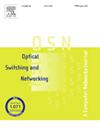一种方便考虑SDM-EON串扰的预禁止频谱策略
IF 3.1
4区 计算机科学
Q3 COMPUTER SCIENCE, INFORMATION SYSTEMS
引用次数: 0
摘要
核间串扰(XT)是空分复用弹性光网络(SDM-EON)的主要缺点。通常有两种方法来考虑串扰,即最坏XT策略和精确XT策略。在分配频谱资源给连接请求时,前者计算最大可能串扰,后者计算精确串扰。最坏情况下的XT策略耗时更少,但带宽阻塞概率更高,而精确XT策略带宽阻塞概率更低,但耗时更长。本文研究了SDM-EON中串扰感知频谱分配问题,提出了一种考虑串扰的预禁止频谱(PFS)策略。在该策略中,分别对中心核心中的三个频谱段和两个边缘核心中的两个频谱段进行预禁,从而减少了剩余频谱段的邻居数量。通过采用PFS策略,减小最大可能串扰,提高最大可选调制电平,从而降低连接请求的带宽阻塞概率。将所提出的PFS策略与最坏XT和精确XT策略进行了比较。仿真结果表明,PFS策略的带宽阻塞概率远低于最坏情况下的XT策略,略高于最坏情况下的XT策略,而PFS策略的平均运行时间远小于最坏情况下的XT策略,与最坏情况下的XT策略相似。因此,PFS策略具有两种比较策略的优点。本文章由计算机程序翻译,如有差异,请以英文原文为准。
A pre-forbidden spectrum strategy to conveniently consider crosstalk in SDM-EON
Inter-core crosstalk (XT) is a main disadvantage in space division multiplexing elastic optical network (SDM-EON). Two methods are commonly used to consider crosstalk, namely worst-case XT strategy and precise XT strategy. When assigning spectrum resources to a connection request, the former calculates the maximum possible crosstalk, and the latter calculates the precise crosstalk. The worst-case XT strategy costs less time but leads to a higher bandwidth blocking probability, while the precise XT strategy gets a lower bandwidth blocking probability yet spends more time. In this paper, we study crosstalk-aware spectrum assignment problem in SDM-EON and propose a pre-forbidden spectrum (PFS) strategy to consider crosstalk. In the proposed strategy, three spectrum segments in the central core and two fringe cores are pre-forbidden respectively, which reduces number of neighbors of the remainder spectrum segments. By using the PFS strategy, the maximum possible crosstalk decreases and then the maximum optional modulation level increases, which can reduce bandwidth blocking probability of connection requests. The proposed PFS strategy is compared with the worst-case XT and precise XT strategies. Simulation results show that, bandwidth blocking probability of the PFS strategy is much lower than the worst-case XT strategy and slightly higher than the precise one, while average running time of the PFS strategy is far less than the precise XT strategy and similar to the worst-case XT one. Hence, the PFS strategy has the benefits of both comparison strategies.
求助全文
通过发布文献求助,成功后即可免费获取论文全文。
去求助
来源期刊

Optical Switching and Networking
COMPUTER SCIENCE, INFORMATION SYSTEMS-OPTICS
CiteScore
5.20
自引率
18.20%
发文量
29
审稿时长
77 days
期刊介绍:
Optical Switching and Networking (OSN) is an archival journal aiming to provide complete coverage of all topics of interest to those involved in the optical and high-speed opto-electronic networking areas. The editorial board is committed to providing detailed, constructive feedback to submitted papers, as well as a fast turn-around time.
Optical Switching and Networking considers high-quality, original, and unpublished contributions addressing all aspects of optical and opto-electronic networks. Specific areas of interest include, but are not limited to:
• Optical and Opto-Electronic Backbone, Metropolitan and Local Area Networks
• Optical Data Center Networks
• Elastic optical networks
• Green Optical Networks
• Software Defined Optical Networks
• Novel Multi-layer Architectures and Protocols (Ethernet, Internet, Physical Layer)
• Optical Networks for Interet of Things (IOT)
• Home Networks, In-Vehicle Networks, and Other Short-Reach Networks
• Optical Access Networks
• Optical Data Center Interconnection Systems
• Optical OFDM and coherent optical network systems
• Free Space Optics (FSO) networks
• Hybrid Fiber - Wireless Networks
• Optical Satellite Networks
• Visible Light Communication Networks
• Optical Storage Networks
• Optical Network Security
• Optical Network Resiliance and Reliability
• Control Plane Issues and Signaling Protocols
• Optical Quality of Service (OQoS) and Impairment Monitoring
• Optical Layer Anycast, Broadcast and Multicast
• Optical Network Applications, Testbeds and Experimental Networks
• Optical Network for Science and High Performance Computing Networks
 求助内容:
求助内容: 应助结果提醒方式:
应助结果提醒方式:


